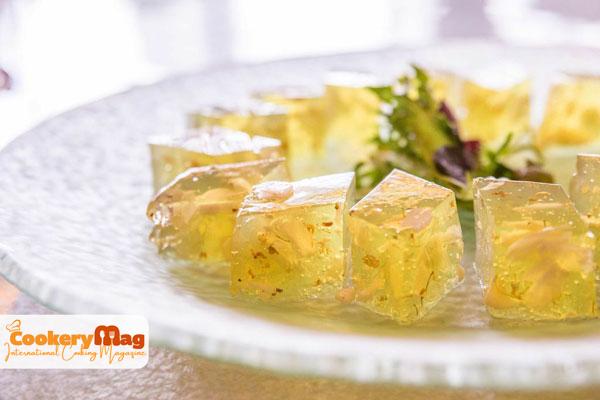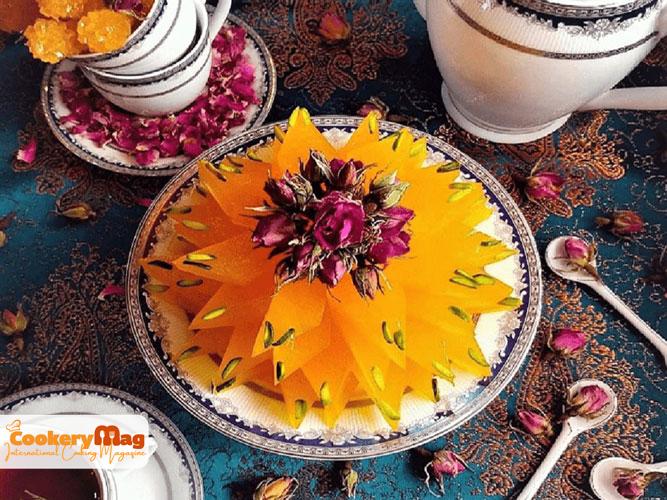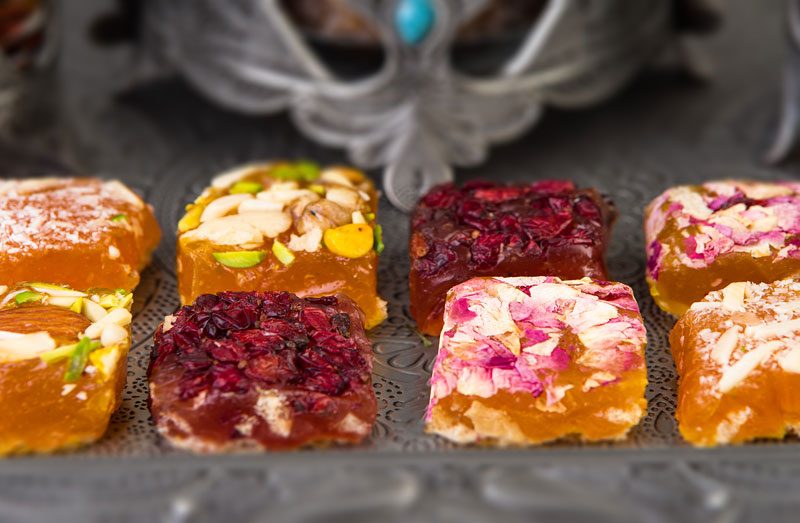© All Rights Reserved.
Masghati recipe | Persian saffron and rosewater sweet, Ceremonial tasty sweet in just 4 steps
Masghati is fresh, fragrant, bright, and perfect Iranian sweet. Masghati from Lar, the authentic one and is one of the popular sweets and souvenirs of Lar City, which has gained many fans day by day inside and outside the country.
One of the most important things to do when traveling to Fars province is to buy authentic Lari Masghati. But if you want to prepare this original halva at home, you can be with the Cookery Magazine.
Ingredients for making Masghati
| Starch | 1 cup |
| Water | 7 cups |
| Sugar | 3 cups |
| Confectionary butter or solid oil | ½ cup |
| Rose water | 4 tablespoons |
| Slivered almond | As much as needed |
| Cardamoms | As much as needed |
| slivered pistachio | As much as needed |
| Ground cardamom | As much as needed |
| Brewed saffron | As much as needed |
Recipe for making Masghati
The first step

To make Masghati, first, soak the starch in water to remove its sourness. Then pour the soaked starch with water into a suitable container and stir.
After the starch is dissolved in the water, pass it through a strainer several times until it is smooth and uniform, but the water should not be reduced.
Finally, pour the smooth and homogenized contents into a pot of the right size and put it on the heat.
The second step
Add sugar and butter (if desired, solid oil) to the starch you put on the heat and let it boil and thicken.
When your ingredients boil and reach the right consistency, add saffron for its fragrance, and give a beautiful color to the ingredients, and stir constantly so that it does not stick.
The third step

After the material reaches a sufficient consistency, i.e. it becomes thicker than Ferni, add rose water to it (at this stage, you can also add slivered pistachio or almond if you wish) and after boiling for 2 to 3 minutes, turn off the heat.
When the ingredients become a paste, pour it from the pot into a pre-greased rectangular container and smooth it.
The fourth step
Finally, decorate it with sliced almonds or pistachios. Place Masghati in the refrigerator until it takes the desired shape, you can cut it to your desired shape after it cools down and eat it as a delicious dessert.
Golden tips for having the best Persian saffron and rosewater sweet
- The amount of sugar used depends on your taste.
- You can make this food without oil or with little oil.
- Store masghati in a sealed container that does not allow air to penetrate.
- Remember that you can stored masghati in the freezer for several months.
- People with high blood sugar and fat should be careful when consuming masghati.
- Masghati should be a little soft and pasty; Harder Masghatis are not fresh; The fresh Masghati smells like cardamom and rose water.

- This candy can also be made with cocoa flavor, by adding cocoa powder to the refined and sieved starch to give it a cocoa flavor and color.
- Market masghatis are harder and have a longer cooking time (at least three to four hours), while oil is added little by little in several stages at the end.
- Use slivered pistachio and almond only to decorate the masghati; The combination of pistachio and almond slices with masghati will make muscati very tasty in addition to beauty.
- Take care while removing the cake from the mold so that its form is not damaged; It is better when remove masghati from the mold using a wet knife and leave it at room temperature for a short time.
In the early hours of making masghati, when the starch is boiling, you should not leave it and you should constantly stir the starch so that the starch is cooked well and does not taste raw;

If you leave the starch alone and do not stir it, the starch will become lumpy and fragmented.
Types of Persian saffron and rosewater sweet
- Saffron masghati
- Saffron with milk masghati
- Saffron with corn starch masghati
- Saffron masghati with gelatin
- Nutty saffron masghati
Having a journey in the history of Persian Rose Water, Cardamom Pudding
The history of Masghati Halva (which reminds us of Persian Halva) goes back almost two centuries.
When Iranian businessmen, following their visits to the country of Oman and the city of Muscat (Masghat), got to know the masghati, which at that time was not in its current form and was very different from today’s Persian saffron and rosewater sweet.
They learned how to cook it and brought it with them to Bandarlange about two centuries ago, Bandarlange was part of Larestan city at that time.

The name masghati, referring to the historical city of Muscat (the capital of Oman), is the origin of this delicious dish.
So it can be said that Masghati was originally produced and used in Oman.
Even now, more than 20 different types of masghati are prepared in Oman, and it is going to be said that in Oman, masghati is known as Omani halva.
After this delicious sweet came from the country of Oman to the Persian Gulf and the city of Lar, the preparation of authentic Lari masghati was made in Lar many years ago and its fans were added day by day.
Of course, talking about this nutritious dessert and the history of Muscat halwa is meaningless without Haj Mohammad Qanad, and the name of this souvenir is so closely tied to the life of this family that even after more than a century has passed since this art arrived in Iran and Larestan from Oman, his name shines more than before on the windows of hundreds of shops in the city.
The flames that Haj Mohammad ignited since 1301 in the old city of Lar and the northern side of the historical market of Qeysarieh by setting up a traditional halva baking workshop, with his trustworthiness and sense of responsibility for his children and family, are still burning.
He considers the most important factor in the difference between Larian masghati and Omanian masghati to be the way of cooking, the precision and skill of the cook, even the type of dishes used, and of course the quality of its ingredients.

Although Lar city in Fars province is the hub of masghati production in Iran, it is also produced and sold in cities such as Shiraz, Kerman, Kazeroon, Sirjan, Bushehr, Bandar Abbas, etc., but most of the fame of this sweet goes back to the city of Lar; And today we know this sweet as Lari masghati.
It should be noted that over the years, changes have been made in cooking Muscat Halwa.
Persian saffron and rosewater sweet has a jelly-like appearance; But it is a little harder than that and it is not made from fruit, but its ingredients are starch, cardamom, rose water and saffron.
Omanian halwa was named masghati after entering Iran and is now produced and served in different cities.
For a long time, this halva together with biscuits has been an integral part of the parties and celebrations of the people of this land, especially people served it at Yalda night.
Benefits of Halwa Muscatian
This food, with its compounds and high amounts of protein in this halwa, increases the body’s energy level and increases muscle endurance;
For this reason, Masghati traditional medicine experts consider this sweet to be suitable for people who have high physical activity and it is recommended for jobs that require sufficient physical energy, such as construction workers and athletes.

Heider Azmaei (حیدر عظمایی), researcher and scholar of traditional medicine, said about the most important properties of masghati: the high amount of protein in this halva causes general strengthening, increasing the energy level and muscularization of the body, therefore it is suitable for people who do hard physical activities, including workers and athletes, especially It will be very useful for bodybuilders.
He added: Consuming masghati improves the function of the nervous system and strengthens memory and prevents Alzheimer’s.
In traditional medicine, it is said that eating a small amount of muscat can help cure constipation.
Masghati halva contains vitamins A, B, C, E, carbohydrate, sodium, potassium, protein, calcium, iron, phosphorus, magnesium, zinc, folic acid, manganese, omega-3 fatty acid, tryptophan amino acid, selenium, copper, sucrose sugar, glucose and It is fructose.
This researcher of traditional medicine said: that due to the presence of calcium, magnesium, phosphorus, and selenium, this halwa has a significant effect on strengthening bones and teeth and prevents osteoporosis and arthritis.
Hence, it is very useful for the elderly, he added that the tryptophan amino acid in this halwa causes the production of serotonin in the body; Serotonin is uplifting and prevents stress, anxiety, and depression.

Muscat properties and benefits for children
masghati is one of the best foods for children due to its high nutritional value and is also very good for children due to the presence of starch.
In children, there is a possibility of fungus, fungus grows easily in a dark and moist place; Considering that starch has high absorption, you can use it to solve this problem.
Starch powder with soothing and anti-inflammatory properties in traditional medicine is always used to improve inflammation.
Burns and scalding (caused by too many diapers) have been used in babies.

Properties of masghati in pregnancy
Eating masghati is useful during pregnancy due to its high nutritional value, but you should not overdo it, Because it has saffron and because of starch it can be harmful.
High consumption of sugar and sugary substances and starch during pregnancy leads to defects of the nervous system in the fetus.
Excessive consumption of sugary and starchy substances during the first trimester of pregnancy increases the risk of neural tube and spinal cord defects in their children.
Halwa Masghati packaging

It is interesting to know that in the beginning, straw and tin containers were used to pack this type of halva.
Perhaps one of the reasons for using metal containers was the use of the sharp edge of these containers to cut this sweet.
Frequently Asked Questions about Persian saffron and rosewater sweet
How long does Persian saffron and rosewater sweet last?
This sweet can be stored for 3-4 months in closed containers. So you can use this candy for a long time.
How can Persian saffron and rosewater sweet sweets be decorated?
Masghati sweets can be decorated very easily. The easiest way to decorate this delicious sweet is to use roses, walnuts, pistachio slices, almonds, sesame, barberry, and coconut with the combination of desired colors, which gives an attractive color and shape to masghati.
Masghati
Course: sweetCuisine: Perssian foodDifficulty: Normal4
servings20
minutes2
hours0/438
kcalPersian saffron and rosewater sweet, Ceremonial Iranian tasty sweet.
Ingredients
Starch, 1 cup
Water, 7 cups
Sugar, 3 cups
Rose water, 4 tablespoons
Slivered almond, As much as needed
Cardamoms, As much as needed
Slivered pistachio, As much as needed
Ground cardamom, As much as needed
Brewed saffron, As much as needed
Confectionary butter or solid oil, ½ cup
Directions
- The first step
To make Masghati, first, soak the starch in water to remove its sourness.
Then pour the soaked starch with water into a suitable container and stir.
After the starch is dissolved in the water, pass it through a strainer several times until it is smooth and uniform, but the water should not be reduced.
Finally, pour the smooth and homogenized contents into a pot of the right size and put it on the heat. - The second step
Add sugar and butter (if desired, solid oil) to the starch you put on the heat and let it boil and thicken.
When your ingredients boil and reach the right consistency, add saffron for its fragrance, and give a beautiful color to the ingredients, and stir constantly so that it does not stick. - The third step
After the material reaches a sufficient consistency, i.e. it becomes thicker than Ferni, add rose water to it (at this stage, you can also add slivered pistachio or almond if you wish) and after boiling for 2 to 3 minutes, turn off the heat.
When the ingredients become a paste, pour it from the pot into a pre-greased rectangular container and smooth it. - The fourth step
Finally, decorate it with sliced almonds or pistachios. Place Masghati in the refrigerator until it takes the desired shape, you can cut it to your desired shape after it cools down and eat it as a delicious dessert.
Notes
- The amount of sugar used depends on your taste.
- You can make this food without oil or with little oil.
- Store masghati in a sealed container that does not allow air to penetrate.
- Remember that you can stored masghati in the freezer for several months.
- People with high blood sugar and fat should be careful when consuming masghati.
- Masghati should be a little soft and pasty; Harder Masghatis are not fresh; The fresh Masghati smells like cardamom and rose water.
- This candy can also be made with cocoa flavor, by adding cocoa powder to the refined and sieved starch to give it a cocoa flavor and color.
- Market masghatis are harder and have a longer cooking time (at least three to four hours), while oil is added little by little in several stages at the end.
- Use slivered pistachio and almond only to decorate the masghati; The combination of pistachio and almond slices with masghati will make muscati very tasty in addition to beauty.
- Take care while removing the cake from the mold so that its form is not damaged; It is better when remove masghati from the mold using a wet knife and leave it at room temperature for a short time.
- In the early hours of making masghati, when the starch is boiling, you should not leave it and you should constantly stir the starch so that the starch is cooked well and does not taste raw; If you leave the starch alone and do not stir it, the starch will become lumpy and fragmented.
Conclusion
Thank you for being with us so far in this article.
I hope you will experience a delicious Iranian dessert with us and share your experiences with us too.
To enjoy more Roma dishes, you can check our site and also enjoy the variety of Shirazian dishes and desserts such as Faloodeh, Kalam Polo, and Shirazi Salad.
Please share this article with your friends on Facebook, Twitter, Pinterest, and other social media. 🧡



